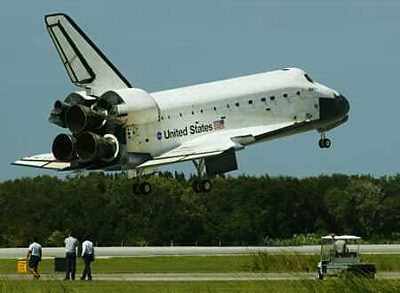Sun, Feb 15, 2004
Shuttle Mods Taking Longer Than Hoped
The chance that America's shuttle fleet will return to flight by
September or October is growing mighty slim. So says NASA
Administrator Sean O'Keefe.

"I have my doubts the September-October time frame will be met,"
O'Keefe said. "We will determine that next week."
Florida Today, a newspaper which closely tracks developments at
the Kennedy Space Center, modifications to add cameras and sensors
to inspect Atlantis while in orbit have run into difficulty and are
weeks behind schedule. At the time, two NASA directors told the
newspaper that it would be tough to make Atlantis ready for flight
as planned -- during the month of September.
There is also the ongoing issue of trying to solve the falling
insulation problem. The Columbia Accident Investigation Board has
said a falling piece of insulation foam from the doomed shuttle's
external fuel tank most likely tore a hole in the left wing,
allowing superheated gasses to breach the vehicle upon re-entry.
That, according to the CAIB, is what caused Columbia to
disintegrate over Texas and Louisiana a year ago, killing all seven
astronauts on board. No shuttle has flown since.

NASA has stated it's determined to meet the fall launch window.
Now, that goal seems in doubt.
Part of the CAIB recommendations on improving flight safety --
recommendations O'Keefe has vowed NASA will follow to the letter --
calls for the shuttle to launch only during daylight and only when
the huge orange external fuel tank can be dropped on the side of
the Earth facing the sun. The idea is to allow NASA to take
detailed photos of the orbiter so they can be inspected for signs
of launch-related damage.
If you do the calculations, you'll find that leaves some fairly
restrictive windows for a return to flight this fall. Under the
guidelines, Atlantis can launch between mid-September and
mid-October. It can also launch in November. But if modifications
aren't complete by then, Atlantis won't be able to launch again
until another such opportunity arises in March, 2005.
More News
Its Offerings Are Lighter, Cleaner, and Now Pushing Past 1,000nm on SAF Jet Fuel DeltaHawk’s diesel-powered aircraft lineup has seen incredible upgrades over the last few yea>[...]
The Airplane Experienced A Total Loss Of Engine Power On December 3, 2025, about 1600 central standard time, a Mooney Aircraft Corp. M20K, N57229, was substantially damaged when it>[...]
Make Sure You NEVER Miss A New Story From Aero-News Network Do you ever feel like you never see posts from a certain person or page on Facebook or Instagram? Here’s how you c>[...]
Aero Linx: European Society of Aerospace Medicine (ESAM) As a pan-European, independent forum, it works to promote the safety and health of all persons involved in aviation and spa>[...]
“We are excited to see Wisk achieve this milestone, and I’m so proud of the team that made it possible. The team at Wisk has built advanced technologies across flight c>[...]
 Aero-TV: DeltaHawks Diesel Power Steps Into the Spotlight
Aero-TV: DeltaHawks Diesel Power Steps Into the Spotlight NTSB Prelim: Mooney Aircraft Corp. M20K
NTSB Prelim: Mooney Aircraft Corp. M20K ANN FAQ: Turn On Post Notifications
ANN FAQ: Turn On Post Notifications ANN's Daily Aero-Linx (12.20.25)
ANN's Daily Aero-Linx (12.20.25) Aero-News: Quote of the Day (12.20.25)
Aero-News: Quote of the Day (12.20.25)




